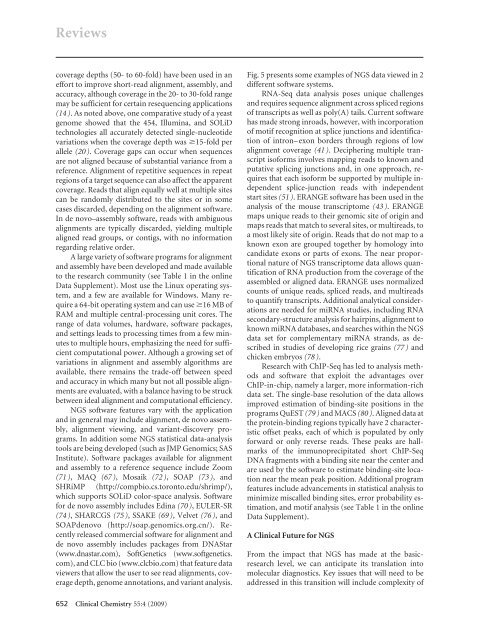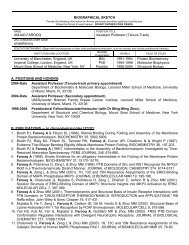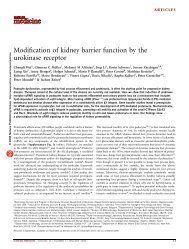Next-Generation Sequencing: From Basic Research to Diagnostics ...
Next-Generation Sequencing: From Basic Research to Diagnostics ...
Next-Generation Sequencing: From Basic Research to Diagnostics ...
You also want an ePaper? Increase the reach of your titles
YUMPU automatically turns print PDFs into web optimized ePapers that Google loves.
Reviewscoverage depths (50- <strong>to</strong> 60-fold) have been used in aneffort <strong>to</strong> improve short-read alignment, assembly, andaccuracy, although coverage in the 20- <strong>to</strong> 30-fold rangemay be sufficient for certain resequencing applications(14). As noted above, one comparative study of a yeastgenome showed that the 454, Illumina, and SOLiDtechnologies all accurately detected single-nucleotidevariations when the coverage depth was 15-fold perallele (20). Coverage gaps can occur when sequencesare not aligned because of substantial variance from areference. Alignment of repetitive sequences in repeatregions of a target sequence can also affect the apparentcoverage. Reads that align equally well at multiple sitescan be randomly distributed <strong>to</strong> the sites or in somecases discarded, depending on the alignment software.In de novo–assembly software, reads with ambiguousalignments are typically discarded, yielding multiplealigned read groups, or contigs, with no informationregarding relative order.A large variety of software programs for alignmentand assembly have been developed and made available<strong>to</strong> the research community (see Table 1 in the onlineData Supplement). Most use the Linux operating system,and a few are available for Windows. Many requirea 64-bit operating system and can use 16 MB ofRAM and multiple central-processing unit cores. Therange of data volumes, hardware, software packages,and settings leads <strong>to</strong> processing times from a few minutes<strong>to</strong> multiple hours, emphasizing the need for sufficientcomputational power. Although a growing set ofvariations in alignment and assembly algorithms areavailable, there remains the trade-off between speedand accuracy in which many but not all possible alignmentsare evaluated, with a balance having <strong>to</strong> be struckbetween ideal alignment and computational efficiency.NGS software features vary with the applicationand in general may include alignment, de novo assembly,alignment viewing, and variant-discovery programs.In addition some NGS statistical data-analysis<strong>to</strong>ols are being developed (such as JMP Genomics; SASInstitute). Software packages available for alignmentand assembly <strong>to</strong> a reference sequence include Zoom(71), MAQ (67), Mosaik (72), SOAP (73), andSHRiMP (http://compbio.cs.<strong>to</strong>ron<strong>to</strong>.edu/shrimp/),which supports SOLiD color-space analysis. Softwarefor de novo assembly includes Edina (70), EULER-SR(74), SHARCGS (75), SSAKE (69), Velvet (76), andSOAPdenovo (http://soap.genomics.org.cn/). Recentlyreleased commercial software for alignment andde novo assembly includes packages from DNAStar(www.dnastar.com), SoftGenetics (www.softgenetics.com), and CLC bio (www.clcbio.com) that feature dataviewers that allow the user <strong>to</strong> see read alignments, coveragedepth, genome annotations, and variant analysis.Fig. 5 presents some examples of NGS data viewed in 2different software systems.RNA-Seq data analysis poses unique challengesand requires sequence alignment across spliced regionsof transcripts as well as poly(A) tails. Current softwarehas made strong inroads, however, with incorporationof motif recognition at splice junctions and identificationof intron–exon borders through regions of lowalignment coverage (41). Deciphering multiple transcriptisoforms involves mapping reads <strong>to</strong> known andputative splicing junctions and, in one approach, requiresthat each isoform be supported by multiple independentsplice-junction reads with independentstart sites (51). ERANGE software has been used in theanalysis of the mouse transcrip<strong>to</strong>me (43). ERANGEmaps unique reads <strong>to</strong> their genomic site of origin andmaps reads that match <strong>to</strong> several sites, or multireads, <strong>to</strong>a most likely site of origin. Reads that do not map <strong>to</strong> aknown exon are grouped <strong>to</strong>gether by homology in<strong>to</strong>candidate exons or parts of exons. The near proportionalnature of NGS transcrip<strong>to</strong>me data allows quantificationof RNA production from the coverage of theassembled or aligned data. ERANGE uses normalizedcounts of unique reads, spliced reads, and multireads<strong>to</strong> quantify transcripts. Additional analytical considerationsare needed for miRNA studies, including RNAsecondary-structure analysis for hairpins, alignment <strong>to</strong>known miRNA databases, and searches within the NGSdata set for complementary miRNA strands, as describedin studies of developing rice grains (77) andchicken embryos (78).<strong>Research</strong> with ChIP-Seq has led <strong>to</strong> analysis methodsand software that exploit the advantages overChIP-in-chip, namely a larger, more information-richdata set. The single-base resolution of the data allowsimproved estimation of binding-site positions in theprograms QuEST (79) and MACS (80). Aligned data atthe protein-binding regions typically have 2 characteristicoffset peaks, each of which is populated by onlyforward or only reverse reads. These peaks are hallmarksof the immunoprecipitated short ChIP-SeqDNA fragments with a binding site near the center andare used by the software <strong>to</strong> estimate binding-site locationnear the mean peak position. Additional programfeatures include advancements in statistical analysis <strong>to</strong>minimize miscalled binding sites, error probability estimation,and motif analysis (see Table 1 in the onlineData Supplement).A Clinical Future for NGS<strong>From</strong> the impact that NGS has made at the basicresearchlevel, we can anticipate its translation in<strong>to</strong>molecular diagnostics. Key issues that will need <strong>to</strong> beaddressed in this transition will include complexity of652 Clinical Chemistry 55:4 (2009)




